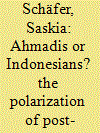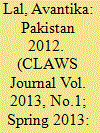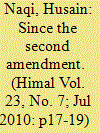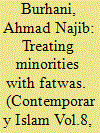|
|
|
Sort Order |
|
|
|
Items / Page
|
|
|
|
|
|
|
| Srl | Item |
| 1 |
ID:
157939


|
|
|
|
|
| Summary/Abstract |
Since the fall of Suharto in 1998, Indonesian public discourse about “mainstream” Muslim identity and practice has polarized sharply into various factions. This article offers a detailed analysis of a subset of this discourse that focuses on the Ahmadiyya in order to grasp how the new normative contours of Islam are being shaped in Indonesia. I make three arguments: First, the discourse is homogenizing what was once a wide spectrum of identitarian positions, and that consequently, Islamic diversity in Indonesia is shrinking. Second, the various internally homogenized sets of arguments for and against the Ahmadiyya mis-engage with each other in a way that produces social fragmentation and further polarization. Third, these arguments produce exclusionary mechanisms that reinforce each other. Both the opponents of the Ahmadiyya and their defenders exclude Ahmadis from conceptions of an Indonesian “majority.” This dynamic in Indonesian public discourse has resulted in the acceleration of the marginalization of the Ahmadiyya within an increasingly fragmented Indonesian society.
|
|
|
|
|
|
|
|
|
|
|
|
|
|
|
|
| 2 |
ID:
135004


|
|
|
|
|
| Summary/Abstract |
This article adds to the literature explaining a rise in the levels of violence and intimidation against the Islamic sect Ahmadiyah in Indonesia. In contrast to approaches that stop at describing the actors or doctrinal differences involved, this article situates the anti-Ahmadiyah discourse in wider processes of maintaining or securing political and social authority. The author first describes how charges of heresy have historically served to consolidate state and political authorities. This analysis is then extended into the post-Soeharto landscape by showing how the charges of heresy against Ahmadiyah have supported fragments of the New Order state to claw back some of the authority lost after the 1998 political transition. Finally, the author situates this process in the context of increased competition among religious authorities. The implications of using such an approach are twofold: first, the Indonesian state's role in the conflict is not defined only by its absence but also by its active involvement; and second, understanding the rise of conservative ulama as part of a wider process of an increase in many different voices weakens the claim that Indonesia is becoming more religiously conservative. The more general conclusion is that the role of academic writing should be to contextualize contemporary discourses of heresy by revisiting some of the methods used in classic heresiology.
|
|
|
|
|
|
|
|
|
|
|
|
|
|
|
|
| 3 |
ID:
137510


|
|
|
|
|
| Summary/Abstract |
The history of Islam and Indonesian nationalism has been one of constant contestation and acquiescence. Although a new openness in discussing Islamic issues has emerged within Indonesia since President Suharto’s rule came to an end, past logics of national cohesion have not dissipated and have in fact contributed to the upheaval over the Ahmadiyya’s position as Indonesian Muslims and Indonesians. Exploring Indonesian Identification Cards (Kartu Tanda Penduduk, otherwise known as KTP), which currently require every applying Indonesian citizen to self-identify with one of six religious options: (1) Islam; (2) Christianity; (3) Catholicism; (4) Hinduism; (5) Buddhism; and (6) Confucianism, I argue that despite the 2008 Indonesian Joint-Ministerial Decree categorizing the Ahmadis as deviant Muslims, KTP offers the group an opportunity to publically declare and receive official recognition of their Muslim identity from the Indonesian government. Thus, a situation has emerged in which contradictory governmental action problematizes religious categories and illuminates the paradoxical nature of Indonesian nationalism.
|
|
|
|
|
|
|
|
|
|
|
|
|
|
|
|
| 4 |
ID:
118496


|
|
|
| 5 |
ID:
096921


|
|
|
| 6 |
ID:
134223


|
|
|
|
|
| Publication |
2014.
|
| Summary/Abstract |
The term "minority religious community" in the Muslim country of Indonesia refers not only to those embracing religions other than Islam, but also to minority groups like the Ahmadiyya. Recently, the treatment of Ahmadis has been worse than the treatment of non-Muslims. This article, therefore, intends to study the status of 'deviant' groups under Islamic law and the treatment of them in Muslim society. Specifically, this article addresses the following questions: How did ulama in the past define and treat minority groups? How do contemporary Sunni ulama define and treat the Ahmadiyya? What is the status of this group under Islamic law? Are they apostates, heretics, or unbelievers? And what are the legal consequences of these charges? To answer these questions, this article employs two methods. First, for theoretical treatment of minority groups in the past, this article focuses its analysis on al-Ghaz?li's Fay?al al-tafriqa and Fa??'i? al-b??iniyya. Second, following a discussion of classical Islam, the article moves to contemporary time by analyzing fatwas against the Ahmadiyya from five institutions: the R?bi?a al-'?lam al-Isl?m?, Majelis Ulama Indonesia (MUI), Muhammadiyah, Council of the Islamic Fiqh Academy of the Organization of Islamic Cooperation (OIC), and Nahdlatul Ulama (NU). This article argues that, first, fatwas against the Ahmadiyya issued by these institutions were intended as a device to sustain orthodoxy of umma and, second, orthopraxy or devoutness in observing religious rituals, as practiced by the Ahmadis, does not exempt them from the charge of apostasy because theologically they are believed to deviate from orthodox beliefs.
|
|
|
|
|
|
|
|
|
|
|
|
|
|
|
|
|
|
|
|
|